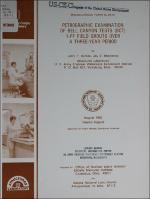Please use this identifier to cite or link to this item:
https://hdl.handle.net/11681/11100Full metadata record
| DC Field | Value | Language |
|---|---|---|
| dc.contributor | United States. Department of Energy | - |
| dc.contributor | Battelle Memorial Institute. Office of Nuclear Waste Isolation | - |
| dc.contributor | Sandia National Laboratories | - |
| dc.contributor.author | Burkes, J. P. | - |
| dc.contributor.author | Rhoderick, Jay E. | - |
| dc.date.accessioned | 2016-06-20T14:14:00Z | - |
| dc.date.available | 2016-06-20T14:14:00Z | - |
| dc.date.issued | 1983-08 | - |
| dc.identifier.uri | http://hdl.handle.net/11681/11100 | - |
| dc.description | Miscellaneous Paper | - |
| dc.description | Abstract: The Bell Canyon field test involving the placement of two grout plugs took place 26 September 1979 (Plug 1) and 14 February 1980 (Plug 2), respectively. Samples cast in the field were brought to WES and cured in hole AEC-7 (lease) brine. Samples were examined periodically through 1 year and then at 2- and 3-years age to obtain petrographic, physical, and some chemical data. This report deals solely with the petrographic data as the physical data have been presented in other reports. Cracking of specimens was observed; this was believed to be due largely to moisture and temperature changes in the laboratory. The two plugs were similar in composition with the Plug 1 grout having more tetracalcium aluminate monosulfate-12-hydrate (C4ASH12) and more garnet-hydrogarnet solid solution series material (hydrogarnet) by X-ray diffraction (XRD) than Plug 2. Tetracalcium aluminate dichloride-10-hydrate (C3A(CaCl2)H10 was present in both samples in varying amounts at different ages. The amount of C3A(CaCl2)H10 in the samples was probably controlled by the proximity of the surface examined by XRD to the brine the samples were stored in. The Plug 2 grout contained more ettringite and calcium hydroxide; Plug 1 grout contained more detectable calcium silicate hydrate (C-S-H). The grout to host anhydrite rock bond appeared to be tight with no visible cracking in simulated borehole (SBH) samples that were examined immediately after fracturing. A white precipitate was found on samples of both events during storage and is believed to be a combination of some chemical reaction between the groundwater and grout as well as precipitate from the brine. It had no detectable detrimental effects. The infiltration of the brine during placement of the grout in satellite Holes 3 and 4 weakened the grout and retarded some of the grout so that it did not harden. The XRD examinations of both Plug 1 and Plug 2 grouts point out that chloride and carbonate ions from the brine are causing some alteration to the original phases at and near the contact of grout and brine. After 3 years of storage, this alteration has penetrated the grout to a depth of about 1 or 1.5 in. with the severity of alteration becoming less with increasing distance from contact surfaces. The grout from the two placements at ages up to 3 years showed no significant overall deterioration or alteration from the original grout. The Plug 1 and Plug 2 samples will continue to be examined by XRD and SEM at 1-year intervals for an indefinite time. | - |
| dc.publisher | Structures Laboratory (U.S.) | - |
| dc.publisher | Engineer Research and Development Center (U.S.) | - |
| dc.relation | http://acwc.sdp.sirsi.net/client/en_US/search/asset/1036127 | - |
| dc.relation.ispartofseries | Miscellaneous paper (U.S. Army Engineer Waterways Experiment Station) ; SL-83-12. | - |
| dc.rights | Approved for public release; distribution is unlimited. | - |
| dc.source | This Digital Resource was created from scans of the Print Resource | - |
| dc.subject | Bell Canyon Tests | - |
| dc.subject | Grouts | - |
| dc.subject | Petrographic analysis | - |
| dc.subject | Petrographic examination | - |
| dc.subject | Mortar | - |
| dc.subject | Grouting | - |
| dc.subject | Radioactive waste disposal | - |
| dc.subject | Underground structures | - |
| dc.title | Petrographic examination of Bell Canyon Tests (BCT) 1-FF field grouts over a three-year period | - |
| dc.type | Report | en_US |
| Appears in Collections: | Miscellaneous Paper | |
Files in This Item:
| File | Description | Size | Format | |
|---|---|---|---|---|
| MP-SL-83-12.pdf | 5.69 MB | Adobe PDF |  View/Open |